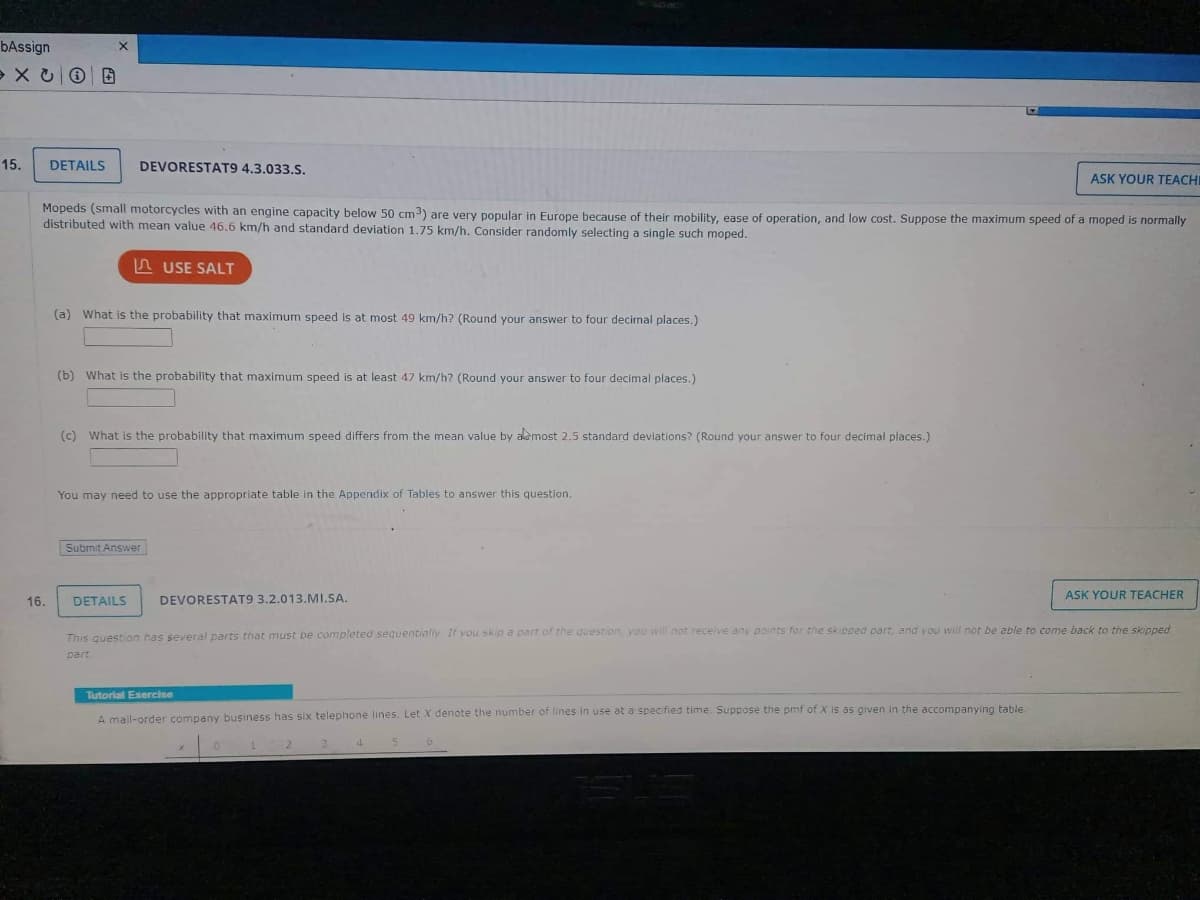Mopeds (small motorcycles with an engine capacity below 50 cm³) are very popular in Europe because of their mobility, ease of operation, and low cost. Suppose the maximum speed of a moped is normally distributed with mean value 46.6 km/h and standard deviation 1.75 km/h. Consider randomly selecting a single such moped. USE SALT (a) What is the probability that maximum speed is at most 49 km/h? (Round your answer to four decimal places.) (b) What is the probability that maximum speed is at least 47 km/h? (Round your answer to four decimal places.) (c) What is the probability that maximum speed differs from the mean value by almost 2.5 standard deviations? (Round your answer to four decimal places.)
Mopeds (small motorcycles with an engine capacity below 50 cm³) are very popular in Europe because of their mobility, ease of operation, and low cost. Suppose the maximum speed of a moped is normally distributed with mean value 46.6 km/h and standard deviation 1.75 km/h. Consider randomly selecting a single such moped. USE SALT (a) What is the probability that maximum speed is at most 49 km/h? (Round your answer to four decimal places.) (b) What is the probability that maximum speed is at least 47 km/h? (Round your answer to four decimal places.) (c) What is the probability that maximum speed differs from the mean value by almost 2.5 standard deviations? (Round your answer to four decimal places.)
A First Course in Probability (10th Edition)
10th Edition
ISBN:9780134753119
Author:Sheldon Ross
Publisher:Sheldon Ross
Chapter1: Combinatorial Analysis
Section: Chapter Questions
Problem 1.1P: a. How many different 7-place license plates are possible if the first 2 places are for letters and...
Related questions
Question
Answer a,b,c ty

Transcribed Image Text:bAssign
XCO E
15.
DETAILS
16.
X
DEVORESTAT9 4.3.033.S.
Mopeds (small motorcycles with an engine capacity below 50 cm³) are very popular in Europe because of their mobility, ease of operation, and low cost. Suppose the maximum speed of a moped is normally
distributed with mean value 46.6 km/h and standard deviation 1.75 km/h. Consider randomly selecting a single such moped.
USE SALT
(a) What is the probability that maximum speed is at most 49 km/h? (Round your answer to four decimal places.)
(b) What is the probability that maximum speed is at least 47 km/h? (Round your answer to four decimal places.)
(c) What is the probability that maximum speed differs from the mean value by almost 2.5 standard deviations? (Round your answer to four decimal places.)
You may need to use the appropriate table in the Appendix of Tables to answer this question.
Submit Answer
DETAILS
DEVORESTAT9 3.2.013.MI.SA.
Tutorial Exercise
A mail-order company business has six telephone lines. Let X denote the number of lines in use at a specified time. Suppose the pmf of X is as given in the accompanying table.
This question has several parts that must be completed sequentially. If you skip a part of the question, you will not receive any points for the skipped part, and you will not be able to come back to the skipped
part
3
4
ASK YOUR TEACHI
5
6
ASK YOUR TEACHER
Expert Solution
This question has been solved!
Explore an expertly crafted, step-by-step solution for a thorough understanding of key concepts.
Step by step
Solved in 4 steps with 4 images

Recommended textbooks for you

A First Course in Probability (10th Edition)
Probability
ISBN:
9780134753119
Author:
Sheldon Ross
Publisher:
PEARSON


A First Course in Probability (10th Edition)
Probability
ISBN:
9780134753119
Author:
Sheldon Ross
Publisher:
PEARSON
